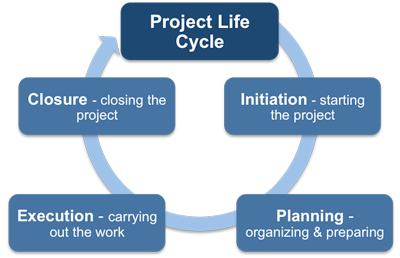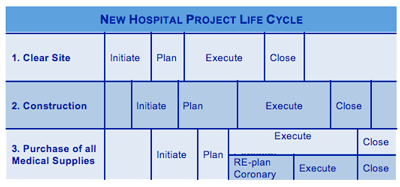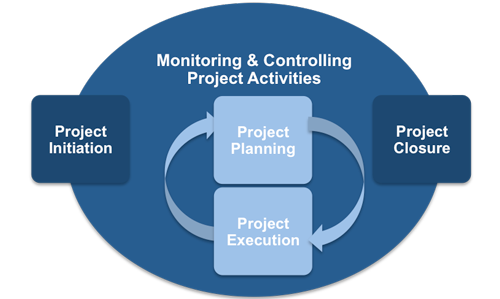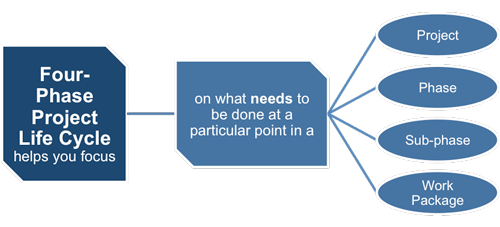Project Management Processes
Projects are temporary structures set up with the specific aim of delivering an identifiable end-product. All projects will therefore have an identifiable life cycle, the characteristics of which will vary according to the size and complexity of the project. However, all projects can be mapped to the following simple life cycle structure:
1. Starting the project
2. Organizing and preparing
3. Carrying out the work
4. Closing the project
 |
This is known as a four-phase life cycle and the phases are usually referred to as:
1. Project Initiation
2. Project Planning
3. Project Execution
4. Project Closure
Looking at a project in this way can help you to understand what it is that makes a project different from a business process but it can also lead to confusion because it represents a gross over-simplification of what happens in most projects.
For example, consider the following example of a project to build a new hospital. The project sponsor is the area health authority. The project is divided into three phases:
1) Clearing the site
2) Constructing the buildings
3) Commissioning the medical facilities.
These phases are not divisions of the project based on time, but are stages of the project that produce a major deliverable.
They are usually sequential, but they sometimes overlap. For example: the phase 'Constructing the buildings' could begin before the whole site was completely cleared and medical equipment could be moved into parts of the building before construction was completely finished.
When you divide a project into phases like this, it is usual to manage each phase as a project in its own right. For example, clearing the site would have its own initiation and planning process and would probably be nearing closure before the second phase 'Constructing the buildings' began its execution phase.
It is quite conceivable that issues that came to light during the clearing phase would impact on the construction phase. For example, the clearing phase might uncover issues with the land that mean that the foundations needed to be modified.
 |
Later on in the project, the commissioning phase could be subjected to scope changes and re-planning because of changes to healthcare policy, changes to health and safety regulations, new medical equipment becoming available, etc. For example, imagine the project is at the point where the building work is nearing completion and medical equipment is being transferred over from other hospitals and bought in from suppliers. The health authority then receives a government grant for several million dollars to spend on acute coronary care.
At this point, they could decide to re-scope the parts of the project that deal with the coronary care unit. This would result in major re-planning of this area of the project but without affecting other areas, which would be nearing closure. Looking at the planning process as something discrete that has defined inputs and outputs makes sense because even if it is being done at the same time as one or more of the other processes it is always done in the same way. There is no need to do different types of planning at different stages of the project because planning is planning no matter when you do it and no matter what else is happening at the same time. The reason for describing things in terms of processes at all, is that these groups offer a simplified and idealized way of looking at project management that minimizes the potential for misinterpretation, and makes the whole process easier to understand.
In the real world, a project like this one would have initiation, planning, executing, monitoring and controlling, and closure processes all happening at the same time. Anyone looking at this project that did not have a good understanding of project management processes would probably see it as disorganized and chaotic.
 |
In contrast, someone who was familiar with the processes, even in a simplified and idealized form, would see that there was actually a structured management framework being used.
Before you read any further, make sure that you understand this concept. Project processes DO NOT NEED to happen in sequence throughout the life of the project, neither are they the same as project phases or stages. Processes are executed at a high level for the whole project but they are also repeated at lower levels even down to that of individual work packages when this is necessary.
 |
The processes are guides that are designed to help you to focus on what needs to be done at particular points in a project, phase, sub-phase or work package. The aim of our 'Project Processes' eBook is to help you to identify the appropriate project management process to apply at any point in your own project.
You may also be interested in:
Project Management Processes | Project Initiation Processes | Project Planning Processes | Project Executing Processes | Project Monitoring and Controlling Processes | Project Change Control Processes | Project Closure Processes.
|
|


